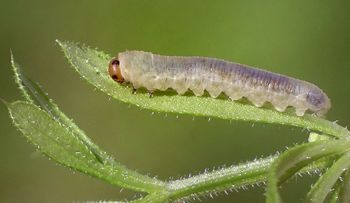
Sawfly larva on Bedstraw
There are some plants for which favorable attributes are difficult to muster. Poison ivy probably tops the list. From our anthropocentric point of view, this plant is nothing but an ugly zit on Nature's fair skin. The same goes for Ragweed, Nettles, Cat Brier, Bedstraw, Sand Burs and Thistles. Come to think of it, poor Mother Nature has quite a complexion problem. But we must remember that beauty is in the eye of the beholder and it is only skin deep. Beauty, as such, holds no real intrinsic value and serves no practical purpose other than to please us, which, of course, isn't really always practical. As I joke about the disconnect between a highly evolved ecosystem, with its myriad interrelated biological bits, and our often simplistic notions of good and bad inspired by a very narrow view of the world that surrounds us, it seems almost impossible to elucidate how that which might appear to be worthy only of disdain can actually be an integral component in the environmental network. Therefore I won't try to explore more than a few small examples.
 Sawfly larva on Bedstraw |
The idea that even weeds are important in some way came to mind recently because it is almost spring here in central Texas and the Bedstraw (Galium sp.) is bustin' out all over. This plant is a prolific annual that goes by various names, including Cleavers, Stickyweed, Grip Grass and Velcro Plant. It rivals kelp in its growth capacity and overtakes many other plants in the cool temperatures of late winter. Given adequate rain, it forms large patches in our backyard, and, true to its various names, it manages to even invade our house by way of the fur on our wire fox terrier. She is not oblivious to it, and usually tries to disengage it from her legs, which results in it wrapping around her muzzle where it is obviously even more annoying. It also sticks to socks, shoe laces, pant legs and human skin.
In spite of it's negative aspects, Bedstraw is actually sort of lovely, if one doesn't touch it. The bright green stems are surrounded by myriad whorls of delicate leaves that look more like an ornamental house plant than a noxious weed. But there I go mentioning an inconsequential attribute again; I'm only human and am easily distracted.
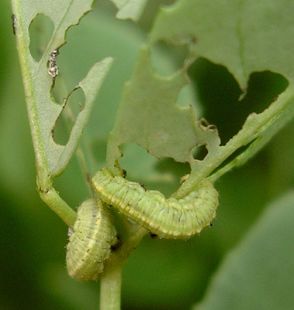 Weevil larvae on Burclover |
Another such tiny glimpse of the bigger picture occurs with Bur Clover (Medicago sp.). A sprawling yellow-flowered relative of Alfalfa, Bur Clover is often the bane of fastidious gardeners and home owners. The wide round leaves crowd out grass and other plants, while the prickly seed pods (the bur part) are another nuisance hitchhiker on everything from clothing to pet fur to human hair. Here in Texas, this plant often grows along with our venerated Bluebonnets (which are weeds we deem to be desirable, but that's another story) and can crowd them out.
As Bur Clover is mostly something that we walk on, many people never really look too closely at it. However, there is a weevil that relishes this plant, and just about wherever it grows undisturbed there are signs of the beetles' consumption. Again, it is a minute fraction of the relationships that result in our biosphere's functioning but clearly illustrates the interconnectedness theme.
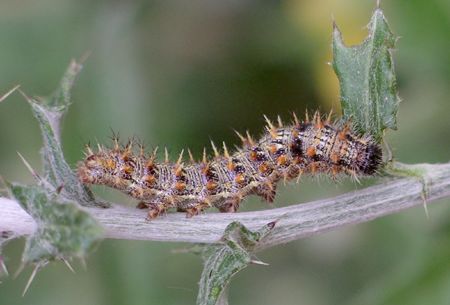 Painted Lady caterpillar on Thistle |
Although thistles have showy purple flowers, our sensibilities find inadequate compensation for the extraordinarily prickly leaves and stems. Thistles not only possess highly effective protection, but they are also large plants, often growing to a height of several feet. Trying to navigate a field dense with this vegetation is not particularly pleasant. But the tender greens under the spiky weaponry are a banquet for various insects, including beetles, flies and moth caterpillars. They are also a favorite food of the Painted Lady butterfly. The larvae construct messy webbed retreats within the thorns and thrive on the succulent flesh at hand. One upshot of the close ties between plant and animal is that the caterpillar has evolved to blend into its bristly background. No venom is present in the spines, and it is safe to handle this species, but the dense array of projections on the insect's body hide it from predators' prying eyes as well as keep small predators and parasitoids at bay.
While I've only mentioned annuals so far, there is a very brawny perennial vine that has few, if any, human devotees. Cat-brier, or Green Brier, (Smilax sp.) sends deep roots into our rocky soil, and grows ever larger with each passing year. If cut to the ground, it returns with a vengeance, thicker
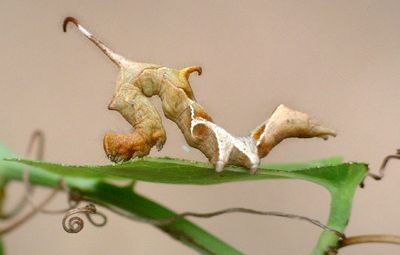 Curve-lined Owlet caterpillar on Cat-brier |
One more intriguing example in this survey of disreputable vegetation and their closely associated creatures is that of the very bothersome nettle called Noseburn and the delicate Common Mestra butterfly. Like other kinds of nettles, Noseburn (Tragia sp.) possesses a thick pelt of fragile spines that break off when touched, releasing an irritating chemical that causes sharp, burning
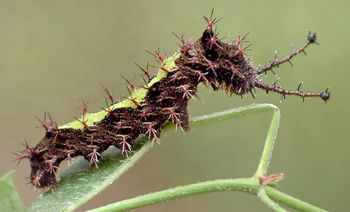 Common Mestra caterpillar on Noseburn |
Just because a plant appears useless, or even malevolent, to us, doesn't mean it is less worthy of existing. The ecology of our planet is such that no organism survives without connections to its fellow associates within the biome. All it takes to discover these links is an open mind, a little curiosity, an ability to research, a bit of imagination in the mystery-solving department and a lot of patience. The elegance, and beauty, of a healthy habitat becomes indistinguishable from the efficiency and productivity of the flora and fauna within it.